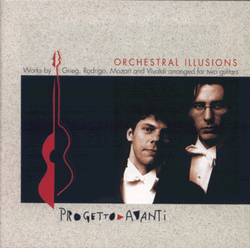
Featured Artist
July, 1997
|
|
Famous Guitarmaker Internet World
Headquarters Featured Artist July, 1997 |
Progetto Avanti
Håkan Frennesson and Max
Gossell
"Orchestral Illusions"

|
Welcome to the special world of
Progetto Avanti. A project designed to illuminate the real capacity of the guitar. One way to achieve this is by expanding the traditional repertoire with our transcriptions of complete orchestral works. A task that forces us to explore every possible (and sometimes even impossible...)
playing technique, perpetually pushing the limits and bending the "rules." Our artistic goal is a new chamber music sound that creates the illusion of an orchestra without being a substitute. And it is our hope that this process will bring you as a listener a few new musical perspectives along the way.... Now, if you really want to enjoy our project - pump up the volume, jump into your favourite chair and HAVE FUN! |
The limitations are always in the mind, never in the fingers.
|
"After listening with pleasure to this brilliant duo, I found the trans- cription of the 'Concierto de Aranjuez' for two guitars most dignified and acceptable." Joaquin Rodrigo |
|
THE MUSICIANS:
After having fooled around a few years with the electric guitar, playing rock and blues, I started to study the classical guitar in 1978 at the age of 19.
I took my Master's Degree in 1986 at the Swedish State Conservatory of Music at the University of Lund with professor Per-Olof Johnson and with professor Jose Tomas in Alicante, Spain. A Fulbright scholarship for one year then rounded off the academic career at the Manhattan School of Music in New York City.
Since my solo debut in 1984,1 have worked as a concert guitarist, street musician, and as an oddjobber in the fields of business, computers and advertising while waiting for a good idea to pop up. Then it did.
In my early teens I experienced Segovia playing a piece on the radio that I desperately wanted to be able to play. One much too difficult piece led to another and I was stuck with classical guitar playing.
My interest soon became a desire to become a professional concert guitarist and I graduated from the same conservatory as Max with a Master's Degree in 1984 and a Soloist Diploma in 1987 under the guidance of professor Per-Olof Johnson. A major scholarship from the Swedish Royal Academy of Music led to further studies with Pepe Romero at the University of California in San Diego 1987-1990, after which I returned to Sweden. After performing and teaching masterclasses in the USA I returned to Sweden to pursue a career as a guitarist.
SELECTIONS
Concierto de Aranjuez
Joaquin Rodrigo (* 1901)
Although we try to enhance the guitar repertoire and technique by the way we work, we can't in a lifetime do what this Spanish composer did in one big blow back in 1939, when he composed his famous 'Concierto de Aranjuez', originally written for solo guitar and orchestra. At last, the guitar had its first major concerto work of importance, and the success was immediate and enormous.
We were honoured by an invitation to visit the composer at his home in Madrid in 1992, and were given the opportunity to discuss the work at large with him. Naturally, this gave US a great deal of inspiration on how to refine and perform our transcription.
The guitar solo pan itself is technically very difficult to play, and it doesn't get any 'better' in our arrangement, where the soloist also has to do a lot of 'orchestral fill ins' as soon as there are any spare fingers left over. To be able to transcribe this work at all, we also had to use quite a few unconventional techniques. For instance, there is no traditional technique to play a bass line and a pizzicato line simultaneously on the guitar, so we had to invent one. The interesting psychological effect these means convey is that - because of their very knowledge of the existing techniques - most guitar aficionados suddenly 'hear' more than two guitars play...
Peer Gynt Suite No. 1
Edvard Grieg (1843-1907)
Being a Scandinavian duo it just felt natural to present a piece that reflects our heritage and mood. Many of us have as children been scared by the frightening theme in 'The Hall of the Mountain King'. Now it's pay back time, even if we are not so sure we would ever like to be referred to as 'scary guitarists' in, let's say, a critics review...
Edvard Grieg is by far Norway's most celebrated composer, not least thanks to his two Peer Gynt suites. Curiously enough though, he was very close to not composing them: the equally famous Norwegian writer Henrik Ibsen asked him in 1874 to write music for his play 'Peer Gynt', which he had written 7 years earlier, in order to increase his chances in getting it performed. Grieg wasn't very fond of the idea, but as he at the time suffered from a kind of negative cash flow - a phenomenon well known to many artists and often referred to as 'being broke'- he finally agreed.
He wrote a total of 23 movements for the play and then later selected the most effective ones and assembled them on purely musical grounds into the two orchestral suites, each of four movements.
Originally we planned to perform the 'Mountain King's' characteristic finale with the kind of leg cymbals you sometimes see street musicians use, but they made us look less chic in our tails so we had to settle for good old foot stomping instead.
Eine kleine Nachtmusik
Wolfgang Amadeus Mozart (1756-1791)
Mozart is Mozart, what more is there to say? He was probably the greatest musical mind the world has ever seen. A genius who in his short life composed over 600 works, end 'Eine kleine Nachtmusik' is one of them. This piece rises above all other composer's works in the serenade genre, and to say it's famous is almost an understatement. Perhaps it is also performed a bit too often for its own good. At least in musical circles it is fashionable to turn up one's nose at this piece of 'mealtime music'. We used to do the same, until we once needed just such a piece ("long and easy to play") for a well paid 'mealtime gig' in the beginning of the Avanti career. Our repertoire is for natural reasons very physically demanding, forcing us to spend fortunes on massage and the like, and this time we wanted to save our hands for 'higher purposes' as much as possible.
Well, Mozart really made fools of us! When we started to look in to the piece we understood we had never really bothered to listen to it before. For instance, the piece is loaded with small, intricate contrapuntal lines that sometimes are hidden by the compact sound projected by many strings playing together. On a plucked instrument such as the guitar, these kind of lines are automatically more chiselled out. Then by removing some of the many repeats, we suddenly had in our hands a very interesting, equilibristic sounding concert piece!
So, did the piece at least turn out to be easy to play? Well, what do you think...?
Concerto in D major
Antonio Vivaldi (1678-1741)
During his last 40 years the Italian Antonio Vivaldi wrote an astonishing 750 works, of which more than 450 were concertos. It wouldn't be unfair to say that the concerto form itself, with a fast first movement, a slow middle movement and a brisk final movement, was more or less "invented" by Vivaldi, and it has been the standard for concertos ever since.
The four concertos that together constitute 'The Four Seasons' are undoubtedly some of his best known works (yes, they are on our schedule...) but this small concerto for lute and strings is quite often performed as well. The solo pan is technically easy to play, and the form structure is not very complicated. Throughout the piece Vivaldi uses an A1A2B1B2 form in each movement, and according to the custom at that time the performer was expected to improvise a development of the melodic line in the repeats. Once upon a time this was a way to show of one's 'musical macho' and they even had competitions in it, but now it is not such a big deal. Just do as many rock musicians do: if you can't improvise well enough, compose an 'improvisation'- at least that's the way we did it...
In both the outer movements we use the rasguado - a technique classical guitar playing has borrowed from the Flamenco music - and there are no such things in the original score. In the third movement we use it to magnify an orchestra tutti, but in the first we replaced a few accompaniment bars in the solo pan with it just for the fun of it. May Vivaldi's soul forgive us!
This project would not exist today without the support from family,
friends, music critics, concert promoters, institutions and sponsors.
You all had the courage to believe in our dream from the very
beginning, and it was this trust in our task that kept us going
through the rough times. Thanks to you all.
Some of you have along the way been of real great importance to the
project's progress, and our way to say thanks is by listing you here
to the right.
And finally, below we would like to especially thank those who have
been of crucial importance to this project's very survival:
Jari Tiessalo at Finlandia Records and Michael Letchford at Warner Classics International, London, for giving us a break.
Maestro Joaquín Rodrigo with family, Madrid, for their great generosity and encouraging support.
Record producer Dragan Buvac, Malmö, for showing us all we know about digital recording. And once again - thanks for the laughs and the blues. . .
Peter D'Addario at J. D'Addario & Company, New York, for giving us all their support and for making such excellent strings.
Daniela Gossell, creative advisor and patient wife
Äke Hedström, photographer, Malmö
Jerker Antoni, computer dealer, musician & inspirational madman, Stockholm
Mats Karlsson, Sparbanken Sverige AB, Malmö
Helge Ax: son Johnson's Foundation, Stockholm
The Crafoord Foundation, Lund
The Swedish Institute
The Swedish Arts Grants Committe
The Swedish International Development Authority (SIDA)
The Swedish National Council for Cultural Affairs
The Swedish Ministry for Foreign Affairs
Exclusively involved in this CD production:
Gösta Hjelmqvist at Erato Soundside AB, Stockholm
Martin Grönlund at Panasonic Svenska AB, Stockholm
Anders Bley at Toshiba Electronics Scandinavia AB, Stockholm
Niklas Luthman at Luthman Scandinavian AB, Stockholm
Leif Strömberg at Imation Sweden AB, Stockholm
Anders Aronsson at FitzPatrick Import Group AB, Stockholm
Sture Holmberg at Holmberg Cases, Haparanda
Benny Madjar at Musicmania, Malmö
Bertil Josefsson at Svensk Musik AB. Göteborg
Executive producer: Jari Tiessalo
Text, layout, pixel artistry and cover art design: Max
Gossell
Co-writing and research Håkan Frennesson
Photo: Åke Hedström (tail coat shots) and Ingrid
G-Olsson (t-shirt shot)
Produced for Warner/Finlandia Records by Max Gossell and
Håkan Frennesson
Digital recording, editing and mastering: Max Gossell and
Håkan Frennesson
Recorded at Helgeandskyrkan, Lund, Sweden in 1996
The CD has been recorded using Ramirez guitars equipped with
D'Addario Pro Arté Strings.
Further details can be found on the Internet at
http://www.progettoavanti.com.
The CD sells for $12.97.
All works copyright 1996 Progetto Avanti
(Håkan Frennesson & Max Gossell),except Concierto de
Aranjuez copyright 1993 Ediciones Joaquín Rodrigo, Madrid
(arranged and recorded by permission).
WARNER/FINLANDIA RECORDS
0630-17693-2
(International Version titled "Orchestral Illusions")
&
0630-18915-2
(U.K./U.S. Version titled "Orchestral Classics for Two
Guitars")
Directory of our
1995, 1996, 1997, 1998 featured recording artists.
© famous guitarmaker
internet world headquarters site
maintained by cyboboy@cybozone.com